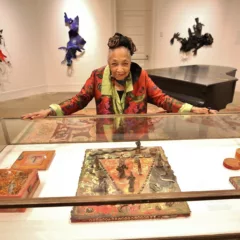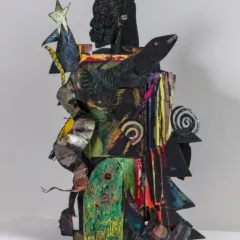Opening just before the holiday at the Art Sanctuary Gallery, a Renaissance has been declared. Emerging artists such as Nile Livingston, Shawn Theodore, Bariq Cobbs, Theodore Harris, and Gabe Tiberino are presented side by side with seasoned veterans of the Philadelphia art scene.
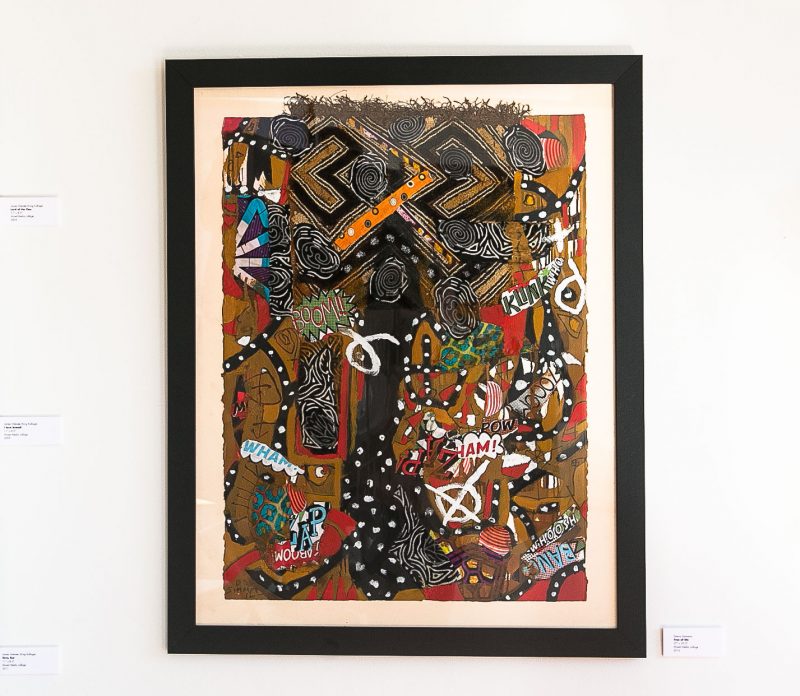
Collage, old and new
Although there were a few paintings and photos on display, the focus of Philadelphia Renaissance is the art of the collage. At first glance, the works assembled on the northern wall of the gallery appear to be similar in style and palette. But upon close scrutiny the individual signature styles of the various artists became apparent. Works by Danny Simmons and Leroy Johnson are standouts in the show. Simmons’ style has evolved to the point that I did not recognize it immediately. In “Tree of Life” (2016), Simmons spins off the patterns in a swatch of Kuba mud cloth, incorporating action words like “Bam” and “Pow” from graphic comics within the composition. The collage is held together with black linear elements that weave in and around the picture plane.
Also of note, nestled between Simmons’ work and that of Leroy Johnson, is a relief collage by Barbara Bullock; this is one of her signature fan works entitled “Soldiers” (2008).
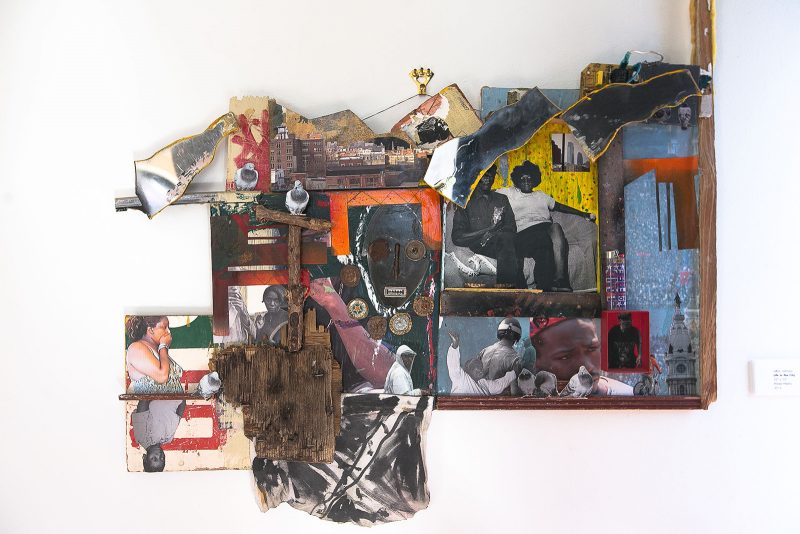
There were two works on display by Leroy Johnson; I gravitated to the irregularly shaped assemblage “Life in the City” (2015). All of Johnson’s usual indicia are included in this multi-media sculptural work, from references to Africa via a diminutive Dan mask juxtaposed next to a small wooden cross made out of twigs, along with photos of West Philadelphia roof tops, City Hall, and interiors spaces. Sheaths of jagged metal placed at the top are woven into a dense composition that suggests a cross section of a Philadelphia row house that has seen a lot of history. The piece is indicative of his signature style.
Of the younger collagists, one work by Bariq Cobbs entitled “Kilimanjaro Nights” (2015) made me pay closer attention to his other pieces on display. In “Kilimanjaro,” the structure of the figure in profile is reminiscent of the Chiwara, a Bambara headdress that references the antelope and appears during male initiation rites. Cobbs’ collages possess the quick hand of the graffiti artist, which is where he may have gained his chops. Two other artists, Al Johnson and James Webster (King Kollage), who have been creating satirical collaged works for decades, draw their inspiration and imagery from pop culture. King Kollage’s “Dirty Rat” incorporates the iconic Disney figure Mickey Mouse touting a hand gun with a five o’clock shadow against a backdrop of dollar bills. I feel compelled to mention the small collages by Theodore Harris. His poignant political commentary resonates today more than ever, particularly the work “In Defense of Thomas Jones” (2002). The case of Thomas Jones involved the use of extreme force by Philadelphia cops in 2000–which was caught on video–in their attempt to arrest Jones for driving a stolen car. The brutality exerted upon Jones elicited a cry of outrage and protests. Harris positions protesters against a background of a burning American flag and his trademark, the Capital building turned upside down.
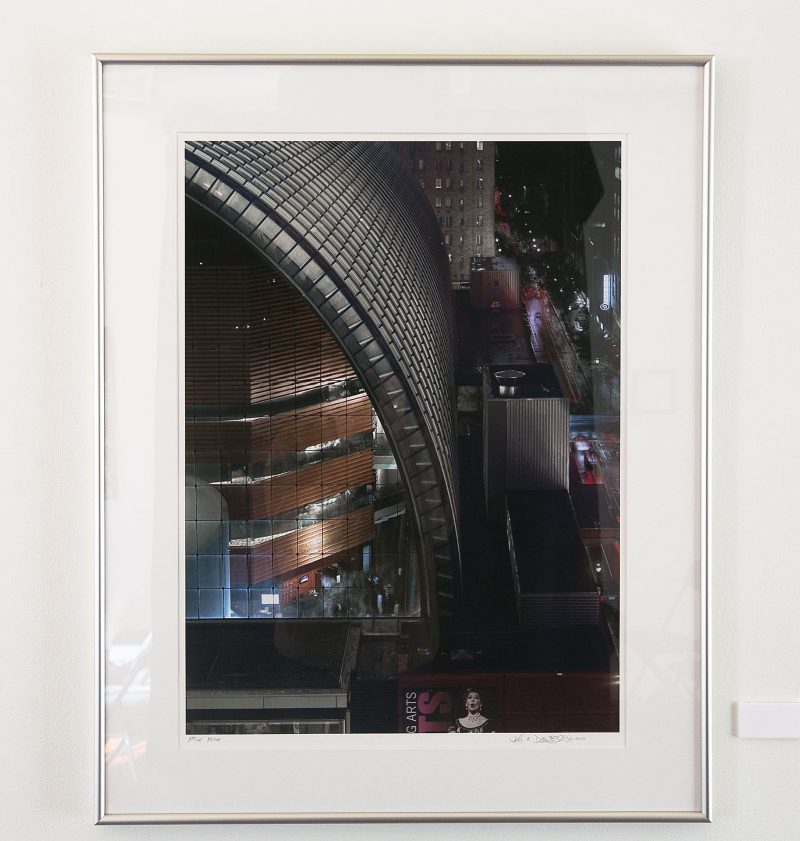
Photography and painting
Newcomers on the scene are Shawn Theodore and Nile Livingston. Shawn Theodore is a photographer who cites John Dowell as a major influence, and not by happenstance his work is presented next to “The Diva” (2015) by Dowell. Dowell has spent the last ten years in the realm of photography, documenting and deconstructing the edifices in major cities across the United States. The central image in “Diva” is the Kimmel Center in downtown Philadelphia. This abstracted photo has not been photoshopped but tricks the eye and dazzles. Photographed from twelve stories up, the reflection of light through the window and extended exposure time resulted in a convergence of architectonic elements.
Theodore’s photos focus on a single subject. “Mrs. Freeman’s Smirk” (2016) is commentary on the church going public. It is a tightly cropped image of the upper torso of a mature woman in a burgundy blazer. The brim of the woman’s hat is visible and complementing her pearl adorned neck is a sliver of a red scarf. Although a small work at 8”x10”, it is quite dramatic.
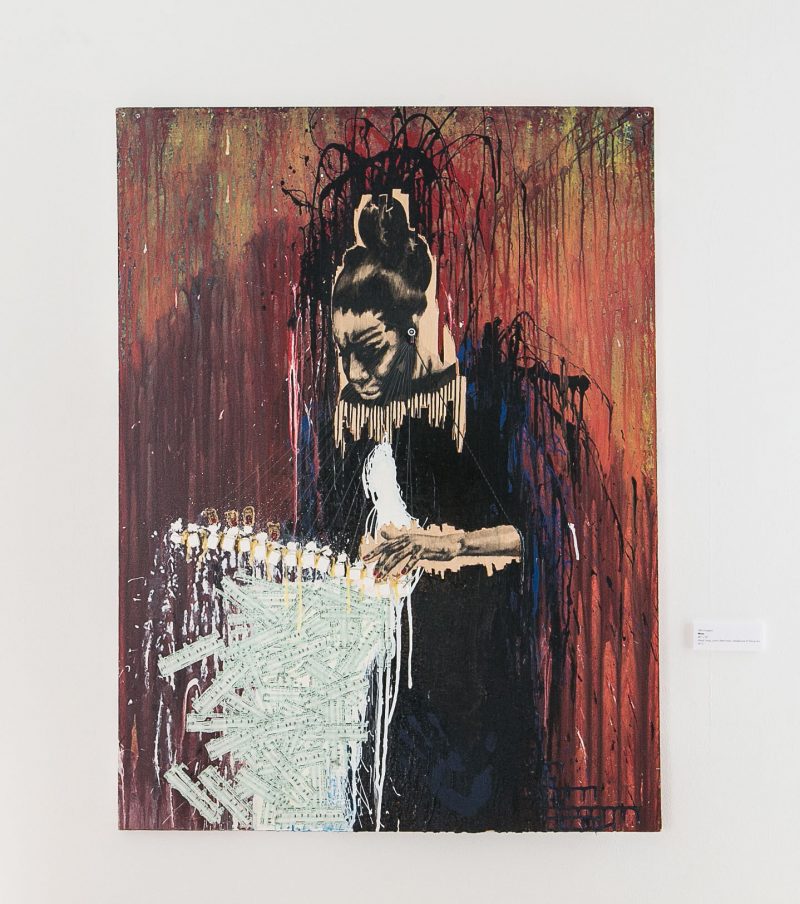
A large portrait of a woman in black leaning slightly toward the left hand side of the picture frame caught my eye immediately upon walking into the gallery. “Nina” (2012) by Nile Livingston is a work unlike others on her website. There is a solid quality about the painting of the black figure shrouded in a midnight blue garment against a dripping sepia- and red-toned background. The mixed media elements (fishing line, headphones, sheet music, wood, twigs) incorporated in the work do not undermine its painterly quality.
I was a little disappointed when I was told the figure was a painting of Nina Simone because of a slight bias regarding celebrity portraits. Yet, this work by Nile has a presence that sets itself apart from standard commercial portraits. And upon close scrutiny there is a likeness and a haunting spirit that can be attributed to Ms. Simone. She is portrayed playing a keyboard, her expressive hands shown on white keys made of wood; however, the body of the piano is missing. Working abstractly, maybe representing the keyboard is a powerful emblem in itself.
There is much to take in given the small boutique scale of the gallery. Small gems abound within this display of modestly sized works. I certainly think the focus on collage and a Philadelphia Renaissance could be springboards for larger projects.
Philadelphia Renaissance is now on display at Art Sanctuary through February 18, 2017. Closing reception Friday, February 18 at 6 PM.





